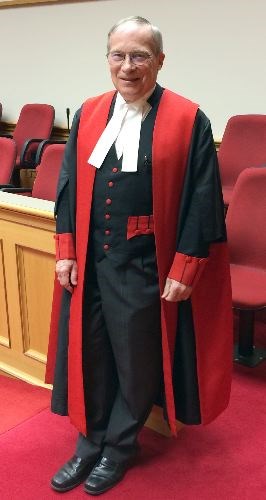A retirement dinner for B.C. Supreme Court Justice Glen Parrett packed a hotel ballroom Thursday night as members of the Prince George legal community gathered to acknowledge the many significant contributions he made over his years on the bench.
And Parrett in return gave his thanks for the support he's received over more than 25 years he's held the post - from family and friends to fellow judges, sheriffs and support staff.
"It's been a long time, it's been a lot of fun, it's been very fulfilling and it's been rewarding in incredible ways," Parrett said.
The praise went in both directions and came from some notable figures.
"On this occasion, it is very important to remind ourselves that an independent judiciary is a fundamental foundation of a democratic society," Prince George Bar Association president Roy Stewart said.
"It does not matter if you happen to be the premier of the province or a homeless person - you must receive a fair hearing and justice without fear or favour. Mr. Justice Parrett epitomized that standard of independence."
Parrett grew up in Victoria but became a practicing lawyer at Hope Heinrich in Prince George after graduating from the University of British Columbia's law school in 1972.
He never really left the city after that.
In 1987, he was appointed Queen's Counsel, a designation used to recognize exceptional merit and contribution to the legal profession, and in early 1990 he was named a B.C. Supreme Court Justice.
He initially sat in Vancouver but within two years was back in Prince George where he became a resident B.C. Supreme Court Justice.
That Parrett became a judge was "only natural," B.C. Supreme Court Chief Justice Christopher Hinkson said, because during his time as a lawyer, he had covered "just about the entire gamut of court work" and was both a defence counsel and a prosecutor.
Parrett has presided over many notable trial over the years and not just on the criminal side.
Hinkson made note of Parrett's landmark 1999 decision in favour of Carrier Lumber, in which he ruled the provincial government had improperly cancelled a timber-harvesting permit to appease a pair of Indian bands and then tried to cover it up.
Parrett described the government's conduct as "deceitful, duplicitous and unethical."
Carrier Lumber eventually reached a settlement of almost $75-million with the B.C. government.
"Like any strong judge, Glen did what he felt was right regardless of the anticipated criticism which the decision was sure to attract," Hinkson said.
And a hint of Parrett's life away from the courthouse was also revealed, notably his close friendship with noted Prince George media figure Ben Meisner.
B.C. Law Society president Kenneth Walker related a humorous story about a time Parrett, dressed in a plaid shirt and blue jeans while having coffee with Meisner at the old Crazy Willy's store.
A friend of Meisner's who did not recognize Parrett asked what he did for a living.
"Oh, I work at the courthouse," Parrett replied.
The conversation continued for some time more and then Parrett left. The friend asked Meisner what Parrett does at the courthouse and was told he was a Supreme Court judge.
"'Oh,' the friend said in disbelief, 'I thought he was a janitor,'" Walker said. "Ben said 'well, sometimes he has to deal with the trash.'"
Parrett's affinity for new technology was also highlighted.
"He acquired one of the first Apple II computers at a time when they cost about what many new automobiles sold for at the time," now-retired B.C. Supreme Court Justice Eric Chamberlist said. "Glen had also acquired one of the original versions of the Motorola cellphone, known officially as the Dynatac 8000, or more commonly known as the brick."
It was last manufactured in 1989, a year before Parrett was appointed a Justice, and weighed one pound, 12 ounces, or 790 grams, Chamberlist noted.
Parrett made a difference outside the courtroom.
Notable among those contributions was working with Meisner to organize on short notice the Condition Critical rally in 2000 that drew more than 7,000 people to the Multiplex, now CN Centre, in the name of improving health care in northern B.C.
The result was the establishment of the Northern Medical Program, designed to encourage medical students to practice in northern B.C. once they've completed training to become physicians.
Parrett was also instrumental in getting a then-new courthouse built at the corner of George Street and Third Avenue. The local landmark, which holds 11 courtrooms and covers 9,700 square metres, was built in 1991.
Known for setting a no-nonsense tone in the courtroom, an appearance before Parrett could be daunting but for the right reasons, those who attended the dinner heard, as he expected counsel to be prepared with thorough, thoughtful and carefully considered arguments.
"Mr. Justice Parrett will be missed, sorely, by all of us," Stewart said. "Your standard of practice, service and acuity are needed. They are needed as attributes in all of us but most importantly in justices and judges of our court who are the last bulwark in the protection of freedom and avoidance of tyranny."
As a gift from the PGBA, Parrett was presented with a framed copy of a consent divorce order he signed in 1986 during one of the last occasions that the courthouse in the historic gold mining town of Richfield was used for the purpose.
Now located in Barkerville, the courthouse was a stop for Judge Matthew Begbie, an icon in the province's history, during his trips through the Cariboo in the 19th century when Richfield was a gold mining town.
Parrett's last day on the job is May 29.



